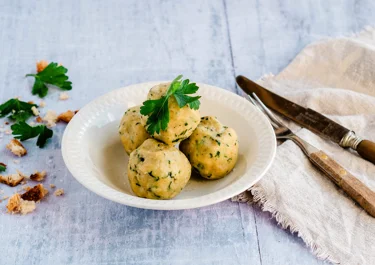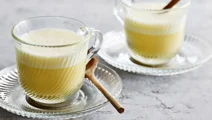Bread dumplings

Impress your guests with a batch of bread dumplings made from stale bread. These traditional bread-based sides fit any dish with succulent meat and delicious gravy. Invite kids and adults into the kitchen to hand shape and form the bread dumplings. Make new memories as you make delicious food.
Ingredients
|
Bread
|
180 g |
|---|---|
|
Onions
|
70 g |
|
Flat-leaf parsley
|
30 g |
|
Butter
|
40 g |
|
Arla Cravendale Whole milk
|
150 ml |
|
Small eggs
|
2 |
|
Breadcrumbs
|
70 g |
|
Flaky salt
|
1 tsp |
|
Freshly ground pepper
|
Instructions
Tip
The primary goal is to ensure the dough holds together when you boil the bread dumplings. It should be slightly sticky but still manageable. If the dough is too dry, you can add a little more milk. If the dough is too wet, add more breadcrumbs until you achieve the desired consistency.
Tips
It is easier to shape the dumplings if you dip your hands in a bit of water. This way, the dough can remain sticky without sticking to your hands.
Tip
Insert a toothpick or skewer into the centre of one of the dumplings to check if they are cooked through. It should come out clean with no raw dough clinging to it.
Try our easy recipe for bread dumplings
Try our easy recipe for bread dumplings that transforms leftover bread into satisfying flavour bombs. Whether it is the first or the hundredth time making these, our straightforward recipe will ensure you cook the perfect batch of bread dumplings every time. With just a few simple steps, you and your closest can experience a rich flavour and soft and chewy textures.
Soft and slightly chewy with fresh herbaceous notes
A single bite is all it takes to find out why people love bread dumplings. Yes, the flavours are incredible, but the combination of textures is just as good. They are known for their soft, pillowy interior perfected by the combination of bread, milk, and eggs. As the dumplings simmer in hot water, they create a slightly chewy exterior that feels nothing short of incredible to bite into to reveal the fluffy, melt-in-your-mouth inside. Chopped parsley brings a freshness that works wonderfully opposite caramelised onion to give the dumplings a complex flavour profile. As a bonus, the little specks of green from the parsley make for an intriguing look.
For other easy-to-make bread-based sides or toppings, try our recipes for breadcrumbs, croutons, and rye bread chips.
A classic Semmelknödel made from stale bread
In German-speaking regions, bread dumplings are known as Semmelknödel and are seen as a bread-based classic. They are traditionally explicitly made from stale bread as a way to use leftovers. But after you have tasted them for the first time, we understand if you cannot wait for bread to turn stale before making bread dumplings. The method has been perfected over time, allowing the bread to soak and become tender in the warm milk. That way, it absorbs all the ingredients that melt together as the dumplings cook. Stale bread is preferred because of its ability to soak up juice and flavour.
What to serve with bread dumplings?
Bread dumplings are a very versatile side that can be paired with several different dishes. They are most commonly served with dishes that include gravy, so they can soak and absorb all the wonderful flavours. Pair bread dumplings with, for example, roast pork, beef stew, or another German classic: the sauerbraten. In these dishes, the bread dumplings mingle with the succulent meat juices and take the gravy to the next level. You can also pair them with creamy soups and tasty stews.
Make it your own
There are several ways to personalise this recipe if you want to alter the flavour or texture.
Start by adding ingredients to the dough mixture. Some popular choices are crispy bacon and diced ham if you wish to add a meaty touch, but you can also add sautéed mushrooms, toasted nuts, or grated cheese. The cheese will provide a slightly creamy texture as you bite into the bread dumplings, while mushrooms bring a savoury and earthy flavour.
For more vegetables, incorporate finely chopped spinach, kale, peppers, or roasted squash. They will all add vibrant, beautiful colours as well as a subtle earthy sweetness. Use them fresh or sautéed in butter for a richer flavour.
While the traditional recipe calls for stale white bread, we encourage you to try different types of bread. Try stale whole wheat bread, rye bread, or even breads with seeds and grains to discover how they affect the flavour and the mouthfeel of the bread dumplings.








